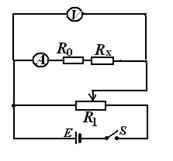问题
实验题
某同学要测量一待测电阻Rx的阻值,备选器材如下:
电流表A,量程为50mA,内阻r=30Ω; 电压表V1,量程为3 V,内阻约为2 kΩ;
电压表V2,量程为15 V,内阻约为4.5kΩ;待测电阻Rx,阻值约为20Ω;
定值电阻R0,阻值为10.0Ω; 滑动变阻器R1。最大阻值为20Ω;
滑动变阻器R2,最大阻值为200Ω; 电源E,电动势为4V,内阻忽略不计;
开关S,导线若干.
实验中要求电表的读数超出量程的 ,能测多组数据,并有尽可能高的测量精确度.
,能测多组数据,并有尽可能高的测量精确度.
(1)该实验中电压表应选用 ,滑动变阻器应选用 ;
(2)在下面的方框中画出实验电路图,标明仪器代号;
(3)如果在实验中,电压表的示数为U时,电流表的示数为I,则待测电阻Rx的阻值表达式为____________.
答案
(1)V1 R1 (2)如图 (3)

题目分析:(1)题中要求电表读数要超出量程的 ,故电压表选V1;经分析可知应选择滑动变阻器分压式接法,故选择R1,电流表内阻已知,当电压表和电流表同时接近满偏时,总电阻为60Ω,故电路如图所示;由欧姆定律知,待测电阻为
,故电压表选V1;经分析可知应选择滑动变阻器分压式接法,故选择R1,电流表内阻已知,当电压表和电流表同时接近满偏时,总电阻为60Ω,故电路如图所示;由欧姆定律知,待测电阻为 。
。
